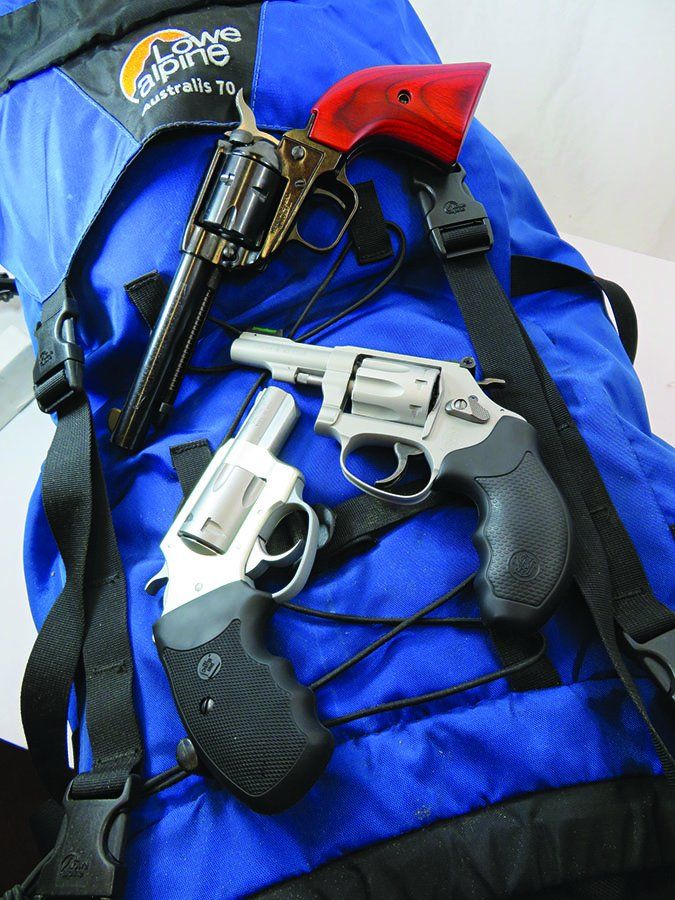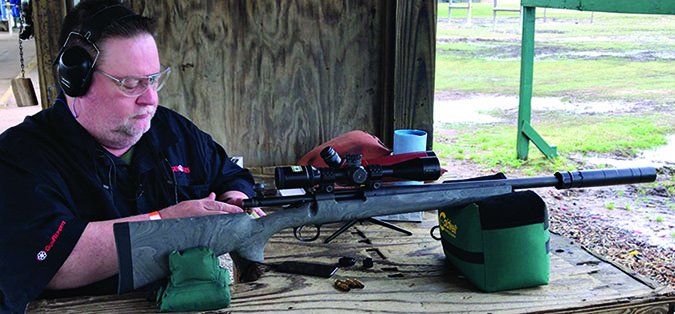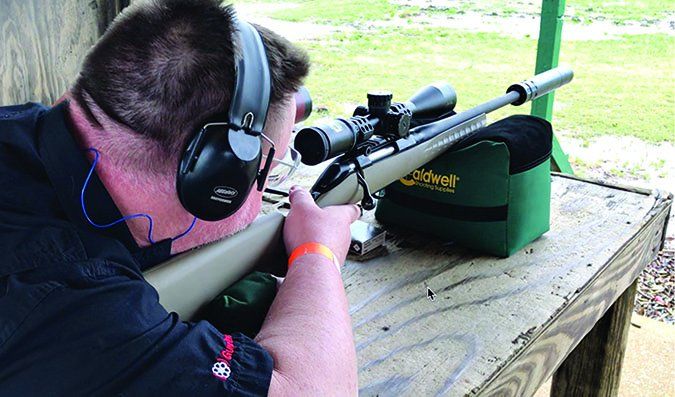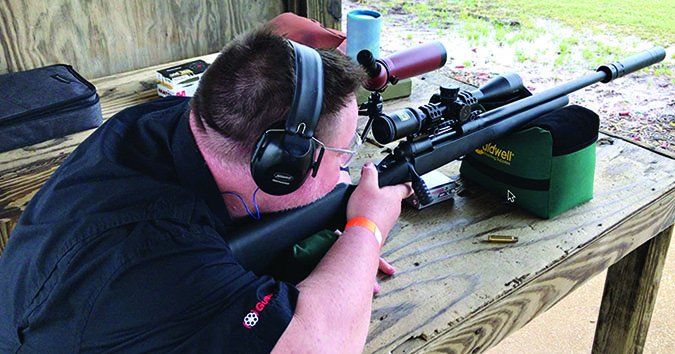Re “Threaded-Barrel Bolt Guns In 300 Blackout and 308 Win.,” May 2018
I was greatly surprised by the positive review that you gave the Ruger rifle. My example would not dependably feed from the magazine, was awkward to single load, frequently failed to fire Remington factory ammunition, and arrived with a stock so warped the barrel was not free floating. When I called Ruger, they read a prepared script, which among other things advised against the use of Remington or Barnes Ammunition. I then sent the rifle back to Ruger. They returned it to me unchanged, although they did include two additional magazines. Unfortunately, the new magazines were no better than the original, and none of the problems addressed. Disappointed, I traded the Ruger for a CZ 527 in 300 BLK. I note that Ruger is now producing a version of this rifle employing AR magazines. — Alan

Sorry you had trouble with your Ruger American Ranch Rifle. But the rest of the readership is now aware of an owner experience they should know about. Thanks for letting us know. The new version you mention that accepts AR magazines is the Model 26968. — Todd Woodard
In your article you describe the Rugged Suppressors Surge 7.62 suppressor that you utilized in your testing. On page 10 you write, describing the suppressor, “… is made of a 17-4 stainless steel called Stellite with a high-temp Cerakote finish.” 17-4 stainless is not called Stellite, they are two separate and distinct alloys. 17-4 stainless is an iron-based precipitation-hardening alloy with 17% chromium, 3 to 5% nickel, and 3 to 5% copper as the principal constituents of the alloy. Stellite is a cobalt-based alloy containing 57% cobalt, 28 to 32% chromium and 11 to 13% tungsten. I looked at the Rugged Suppressors website regarding the Surge 7.62 suppressor, and I see that the build materials are listed as 17-4 stainless and Stellite. Stellite is resistant to the erosive effects of hot, high-pressure propellant gases and is a good choice of material for the internal components of a suppressor. Regards. — Paul
Thank you for the correction on the materials description. — tw
Just got your May issue and in your write up on the rifle comparison, you claim that a suppressor is incorrectly called a silencer. To be nit-picky, a silencer is the technical term as defined by the ATF, the NFA, and in Maxim’s original patent. Regardless of that, keep up the good work. — Michael
Yes, and we recognize both “silencer” and “suppressor” are used interchangeably in modern speech, with silencer being the more widespread usage. Nonetheless, we want to promote the more-accurate term, suppressor, because silencer is audibly wrong, and hearing “silencer” leads to folks believing that’s what the devices do. “Muffler” is better, as is “moderator,” but we recognize it’s a losing battle to try to stamp out “silencer.” We likewise recognize Maxim’s marketing prowess in choosing the word back in the day. Thanks for the note. —tw
Re “Buying Self-Defense Insurance: Important Factors to Consider,” May 2018
“Self-defense insurance” was an unexpected, but welcome, article in your excellent publication. I suspect the bail-bond issues were enlightening to most readers. Although I understand Mr. Cooper’s reasoning for using a plan in which you choose your own attorney, the process of finding one seems overly daunting and suggests I should go with a “plan attorney” who has at least been evaluated by the plan. A follow-up article comparing features of self-defense insurance for some limited number of nationally available plans (USCCA, Armed Citizens’ Legal Defense Network, CCW Safe, and NRA CarryGuard are examples) would be welcomed by this reader. — P. Michael
Gentlemen: With great dismay I noted you wasted a good portion of the May 2018 issue by including an article regarding buying self-defense insurance. If I wanted to learn about same, I would go to a local lawyer or purchase a book on the subject. I am a longtime subscriber to Gun Tests magazine in order to learn about firearms and related gear. In other words, knock off the “filler” articles that have nothing to do with your stated purpose as a magazine, or you risk losing me (and many others) as a subscriber. Happy Trails. — Duane
Sorry you were unhappy. I acted on this only after receiving more than 10 requests for this article from other readers. —tw
Re “New Kit-Gun Revolvers from Charter Arms, S&W, Heritage,” May 2018

Dear Gun Tests: Another awesome issue for this month. I did not have the same experience with two of the revolvers that you guys had. The first one was the Heritage. Over the past twenty or so years, I’ve owned four of them. The first one was used, and the other three were all purchased brand new. Now, none of them had a blade-type sight that the one tested had. They all four had rear sight channels that ran parallel to the bores. And I could accurately shoot none of them. On my last Heritage, I tested 20 different loads, all off a sandbag rest, with the target set at 10 feet. The results were not all that favorable. All the Heritages were well made and fun to shoot. As a matter of fact, while fishing on a creek, I fed a school of bluegill bream when I shot a large nest of red wasps into the water, and I then proceeded to clean up when I cast a fly into the struggling wasps, catching four or five large bream. Not too bad for me. Looking back now, I wish I had used that luck to buy a lottery ticket instead of fishing!
Now to the S&W 317. About 15 years or so ago when I first learned of the 317 Airlite, I bought the first one I could find. Mine is the shorter-barrel version, about 2 inches or so long. And sadly for me it has a sight channel for a rear sight. I’ve had issues with the 317 when low-quality 22 LR ammo falls/slides to the rear of the cylinder, causing the cylinder to jam. Not a big deal; we just don’t carry it with low-quality ammo in the 8-shot cylinder. Now on to the accuracy. It’s almost non-existent. I’ve tested 15 different types of ammo and only about four give decent results. But I bought it as a carry gun/kit gun, and I never intended it to be used at a distance greater than 5 or 6 feet. Which is about where I set the targets out to when I did this testing. But I have yet to find a gun that carries nearly as good as it does. The double-action trigger is serviceable, and the single-action trigger is pretty good. So the moral of this story is that I will never buy a firearm with a rear sight groove! Lesson learned. And I tested all my firearms by shooting off a rest, and measuring the groups and put the data onto a spreadsheet that I made. I checked the results before I sat down to write this letter to you.
Questions about the “self-defense insurance”: First, anything specific that one should Google to search for this insurance? Second: Will the premiums increase if the insurance is ever used? Third: Can one be dropped for using the insurance, like auto insurance? Fourth: Are the insurance premiums different for different age groups. Example: 15- to 20-year-olds generally pay higher premiums for car insurance. Families generally pay lower auto-insurance premiums. Fifth: Does one’s geographic area cause a higher premium? That is, does inner city USA versus deepwoods country USA draw a higher premium? I really enjoyed this issue. Very informative articles, especially the S/D insurance. Never heard of, or thought of, that before. I think it’s a good idea in this time of our lives.
And to make all this better, I see that GT has an upcoming issue dealing with powder dispensers and such. It’s issues like the May edition that caused me to renew my subscription for three more years! Keep them coming. — Mike P.
Hey Mike: If you check the firms listed in the letter above, you can find several companies that offer self-defense insurance. According to the author, attorney Gordon Cooper, the pricing for various programs varies a lot, depending on the amount of coverage you buy. But he hasn’t seen geographic or age-variance premium upgrades that you mentioned. But I’ll pass along your full list of questions and see what we might do on the topic in the future. —tw
It was refreshing to see an article on the versatility of the iconic kit gun, (i.e., a small 22-caliber handgun). I recently purchased an S&W Model 317 and find it to be the ideal companion when hiking or fishing. Its light weight and ease of handling make it the handgun to have when weight and size are important. As an avid hiker, I can easily fit it into my pack or secure it in a holster. I usually use snake-shot rounds as the first two rounds in the gun, followed by Remington Thunderbolts. I recently came upon a rapid raccoon that was rolling on the ground where some hikers were trying to avoid it. Once they moved on, I dispatched it to raccoon heaven, and because the round is fairly quiet, it did not draw much attention. Lightweight, compact, and very dependable, what more could one ask for? — Paul
Re “Firing Line,” May 2018
Hey Todd, your first letter this month from Mike caused me to think maybe it’s not just me. I have a Ruger MK II and an S&W Model 22A that both refuse to operate well with Remington 22 LR ammunition. I can shoot an entire bulk pack of Federal hollowpoints (325 rounds) without a single failure to feed or misfire. I can’t get through a box (50 rounds) of Remington Thunderbolts without at least one round hanging up or misfiring. I also shoot an old Winchester Model 61 rifle that I bought when I was 15, and, although it cycles better than the autoloaders, it also chokes on Remington sometimes and clearly prefers the Federal. Also, why no photos of the threaded-barrel bolt guns with the suppressors attached? — Frank



Here are the bolt actions in the test with the Surge 7.62 suppressor attached. From top are the Remington and Ruger in 300 BLK and the Savage 308 Win. — tw






























